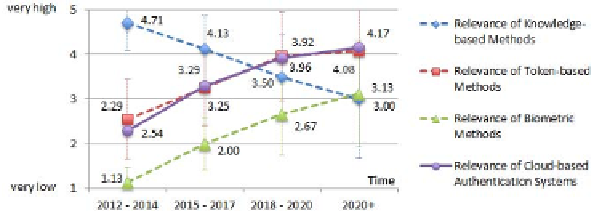Information Technology Reference
In-Depth Information
4.3 Results
Subject of this sub-section is the description and analysis of the gathered data.
RQ1: Development.
The development of the significance of AaaS and (inde-
pendently) general authentication approaches is illustrated by figure 3. Though
the relevance of AaaS is evaluated to be rather low within the next three years,
in the medium to long run the panel forecasts a significant increase and a re-
spective high importance (Median=4)
5
. A congruent development is expected for
token-based authentication methods, indicating the dependence of AaaS on such
methods. This is supported by the evaluation of implementable authentication
procedures. The panel was asked to rank the five most relevant methods regard-
ing the implementation of AaaS in the medium and long term. Here, token-based
methods performed clearly better than all other biometric or knowledge-based
procedures, both for private and business user-centric applications. Table 1 sum-
marizes the results ordered by average rank (business). The data also suggests a
significant decrease of the relevance of knowledge-based methods from currently
very high
to
medium
. The importance of biometrics correlates negatively and
increases from
very low
to
medium
and even subtends the curve for knowledge-
based procedures. H1-H4 are supported.
Fig. 3.
Development of the Relevance of Authentication Methods and AaaS (n=24)
RQ2: Application Fields.
Possible application fields were rated by the panel
on a 5-point
Likert
scale with following semantics: [1]
absolutely not relevant
,
[2]
rather not relevant
,[3]
neutral
,[4]
rather relevant
,[5]
absolutely relevant
.
Regarding organizational application fields, the data indicates the significant
relevance of AaaS for the authentication of partners or corporate customers in a
federation, the enhancement of
Identity & Access Management
(IAM) systems,
the protection of outsourced or cloud applications, and the authentication of
private end users in the public sector. An item was rated to be relevant for a
median greater than or equal to 4. Statistical details are summarized in table 2.
Of 24 experts, 58% name legal or regulative requirements as primary reason for
the adoption of AaaS. Business partner demands are secondary (25%). The eval-
uation of the extent of pain implicated by these drivers was approached looking
5
For all tests regarding median values, in this and the following section, the (non-
parametric)
One-Sample Wilcoxon Signed Rank Test
was applied with
α
=5%.





